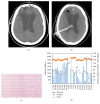The Cushing Reflex: Oliguria as a Reflection of an Elevated Intracranial Pressure
- PMID: 28589048
- PMCID: PMC5447257
- DOI: 10.1155/2017/2582509
The Cushing Reflex: Oliguria as a Reflection of an Elevated Intracranial Pressure
Abstract
Oliguria is one of the clinical hallmarks of renal failure. The broad differential diagnosis is well known, but a rare cause of oliguria is intracranial hypertension (ICH). The actual knowledge to explain this relationship is scarce. Almost all literature is about animals where authors describe the Cushing reflex in response to ICH. We hypothesize that the Cushing reflex is translated towards the sympathetic nervous system and renin-angiotensin-aldosterone system with a subsequent reduction in medullary blood flow and oliguria. Recently, we were confronted with a patient who had complicated pituitary surgery and displayed multiple times an oliguria while he developed ICH.
Figures

Similar articles
-
Discordant orthostatic reflex renin-angiotensin and sympathoneural responses in premenopausal exercising-hypoestrogenic women.Hypertension. 2015 May;65(5):1089-95. doi: 10.1161/HYPERTENSIONAHA.114.04976. Epub 2015 Mar 16. Hypertension. 2015. PMID: 25776076
-
Haemodynamic, renal and hormonal responses to enalkiren in four patients with post-surgical oliguria.Clin Exp Pharmacol Physiol. 1994 Feb;21(2):163-6. doi: 10.1111/j.1440-1681.1994.tb02488.x. Clin Exp Pharmacol Physiol. 1994. PMID: 8039272
-
Activation of the renin-angiotensin system contributes significantly to the pathophysiology of oliguria in patients undergoing posterior spinal fusion.Eur J Anaesthesiol. 2004 Oct;21(10):812-8. doi: 10.1017/s0265021504000109. Eur J Anaesthesiol. 2004. PMID: 15678737
-
Interaction between the renin-angiotensin-aldosterone and sympathetic nervous systems.J Cardiovasc Pharmacol. 1992;19 Suppl 6:S80-8. doi: 10.1097/00005344-199219006-00013. J Cardiovasc Pharmacol. 1992. PMID: 1382170 Review.
-
Cardiovascular care with the new T-type calcium channel antagonist: possible role of attendant sympathetic nervous system inhibition.J Hypertens Suppl. 1997 Dec;15(5):S3-7. doi: 10.1097/00004872-199715055-00002. J Hypertens Suppl. 1997. PMID: 9481610 Review.
Cited by
-
Short-term urinary catheter usage in endoscopic skull base surgery and impact on urinary tract infection and reconstructive outcomes.World J Otorhinolaryngol Head Neck Surg. 2024 Mar 21;11(1):57-65. doi: 10.1002/wjo2.172. eCollection 2025 Mar. World J Otorhinolaryngol Head Neck Surg. 2024. PMID: 40070509 Free PMC article.
References
-
- Boron W. F., Boulpaep E. L. Medical Physiology. Elsevier; 2005.
-
- Salk M. R., Weinstein R. E. On the effects of acutely raised intracranial pressure on diuresis in the dog. American Journal of Physiology. 1939;126:316–325. doi: 10.1007/978-3-642-70971-5. - DOI
-
- James I. M., Wise B. L. The effect of raised intracranial pressure on the handling of sodium by the canine kidney. Jounal of Clinical Science. 1969;36:99–108. - PubMed
Publication types
LinkOut - more resources
Full Text Sources
Other Literature Sources

